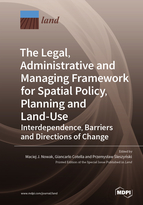The Legal, Administrative and Managing Framework for Spatial Policy, Planning and Land-Use. Interdependence, Barriers and Directions of Change
A special issue of Land (ISSN 2073-445X). This special issue belongs to the section "Land Socio-Economic and Political Issues".
Deadline for manuscript submissions: closed (30 June 2021) | Viewed by 43454
Special Issue Editors
Interests: law; spatial policy; spatial policy tools; spatial planning; environmental protection
Special Issues, Collections and Topics in MDPI journals
Interests: EU territorial governance; spatial planning systems; European territorial cooperation; planning law and property rights; sustainable land use; new institutionalism
Special Issues, Collections and Topics in MDPI journals
Interests: urban geography; population geography; migration studies; geography of enterprise; transport geography; electoral geography; spatial economy; spatial planning; landscape aesthetics
Special Issues, Collections and Topics in MDPI journals
Special Issue Information
Dear Colleague,
The main goal of the Special Issue is to identify and assess how legal-administrative regulations (both at the national, regional, and local levels) contribute in determining the direction of spatial policies, planning, and land-use (with particular emphasis on local spatial policies and planning practices). The wording of specific regulations and procedures applied to individual cases to a large extent determine how effectively it is possible to transform and shape space. In particular, these regulations and administrative solutions should aim to favor spatial order versus spatial chaos, counteract uncontrolled urbanization and incoherent land-use, guarantee the protection of environmental and natural assets, prevent negative externalities on the real estate market, encourage the improvement of quality of life, and strengthen the effective organization of spatial systems. Whereas a conspicuous literature exists that analyses and interprets these regulations from a juridical perspective, the direct (positive and negative) impacts of specific regulations and their wording on spatial policy, planning, and land-use (especially on a local scale) are analyzed much less frequently. This issue seems all the more important from a comparative perspective, as countries and regions may share similar problems and, in turn, gain from exchanging knowledge and learning from each other’s good practices and mistakes.
In the light of the above, the editors of this Special Issue welcome contributions focusing, among other topics, on the following research issues:
- spatial planning, land-use and development regulations, and uncontrolled development and urban sprawl and the role of specific regulations in limiting these phenomena
- spatial planning, land-use and development regulations, and protection of property rights
- law and specialist urban terminology
- regulations concerning land-use, spatial planning and development, and regulations concerning the protection of environment and nature: mutual relations, discrepancies and translation into the scope of protection of the environmental and natural values of individual areas
- the transposition of EU directives and regulations in domestic regulations at the different territorial levels, and the consequent impact on spatial policy and planning practices
- quantitative and qualitative analysis of court decisions concerning spatial policy, planning and land-use tools
- provisions of spatial development plans as legal provisions — their role in the spatial management system
- spatial planning, land-use and development regulations, and the context of public policy and administrative sciences
- spatial planning, land-use and development regulations, and the effects on the real estate market
- the impact of the COVID-19 pandemic emergency on the evolution of spatial planning and land-use law
In particular, contributions focusing on individual case studies (e.g., a method of solving a specific legal dilemma in one city) should be considered insufficient. The authors should rather cover at least the conditions of one country, and when possible should also comparatively refer to literature focusing on other countries. Review papers could also cover a broader international perspective. Contributions comparing different countries will be considered particularly valuable.
The proposed subject covers conditions related to spatial policy, planning and land-use, being fully in line with the thematic scope of the Land journal. The approach, assuming a link between legal sciences on the one hand, and spatial planning, geography, and public policy sciences on the other hand, guarantees an innovative take on the subject, also incorporating perspectives on the implementation of spatial policies. We would encourage interdisciplinary cooperation in this area and will try, as far as possible, to initiate such teams.
Dr. Maciej J. Nowak
Dr. Giancarlo Cotella
Dr. Przemysław Śleszyński
Guest Editors
Manuscript Submission Information
Manuscripts should be submitted online at www.mdpi.com by registering and logging in to this website. Once you are registered, click here to go to the submission form. Manuscripts can be submitted until the deadline. All submissions that pass pre-check are peer-reviewed. Accepted papers will be published continuously in the journal (as soon as accepted) and will be listed together on the special issue website. Research articles, review articles as well as short communications are invited. For planned papers, a title and short abstract (about 100 words) can be sent to the Editorial Office for announcement on this website.
Submitted manuscripts should not have been published previously, nor be under consideration for publication elsewhere (except conference proceedings papers). All manuscripts are thoroughly refereed through a single-blind peer-review process. A guide for authors and other relevant information for submission of manuscripts is available on the Instructions for Authors page. Land is an international peer-reviewed open access monthly journal published by MDPI.
Please visit the Instructions for Authors page before submitting a manuscript. The Article Processing Charge (APC) for publication in this open access journal is 2600 CHF (Swiss Francs). Submitted papers should be well formatted and use good English. Authors may use MDPI's English editing service prior to publication or during author revisions.
Keywords
- spatial policy
- spatial planning systems
- land-use
- spatial planning and land-use regulations and managing
- spatial planning tools
- law and urban terminology
- court decisions
- the influence of coronavirus on spatial organization law
- Europeanisation








